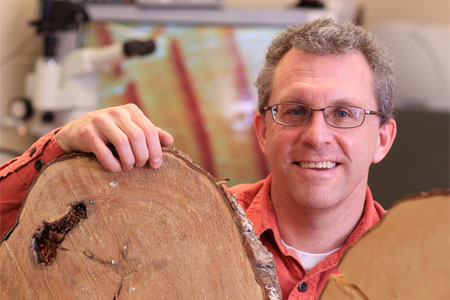Telling the tales of trees
If you’re Colin Laroque, wood has a tale to tell, whether it’s the oldest hockey stick in Canada, a piece of the Titanic, a weather-ravaged scrubby spruce from Labrador or a Manitoba maple from a southern Saskatchewan farm yard.
By University Communications "People started planting shelter belts 100 years ago and they've been planting trees ever since," said Laroque, who started his position as professor in the College of Agriculture and Bioresources and the School of Environment and Sustainability at the beginning of January. "They've planted close to a billion trees."
"People started planting shelter belts 100 years ago and they've been planting trees ever since," said Laroque, who started his position as professor in the College of Agriculture and Bioresources and the School of Environment and Sustainability at the beginning of January. "They've planted close to a billion trees."
Laroque is a dendrochronologist, someone who examines the rings of trees to read the tale of climate change, history and industrial development. His lab—one of only about a dozen of its type in Canada—is sought out by environmental and climate scientists as well as archaeologists across the country.
Laroque spent his formative years between the family's home in Saskatoon and farm near Duck Lake, finishing high school at Bedford Road Collegiate before coming to the U of S for his BSc. He completed his MSc and PhD at the University of Victoria and spent the last 10 years at Mount Allison University in New Brunswick, where he established the nationally recognized Mount Allison Dendrochronology Lab.
The U of S offered Laroque a chance to return to his roots, plus access to a wide range of expertise and advanced analytical tools.
"The synchrotron is very interesting to me. The type of chemical analyses you can do with that machine is amazing.
A recipient of a 3M Teaching Fellowship, Laroque is committed to inspiring students to interact with the natural world.
"I'm all for taking undergrads outdoors. You can teach them in a classroom, but you can also teach them on the banks of the South Saskatchewan River. I want to get them outside!"

